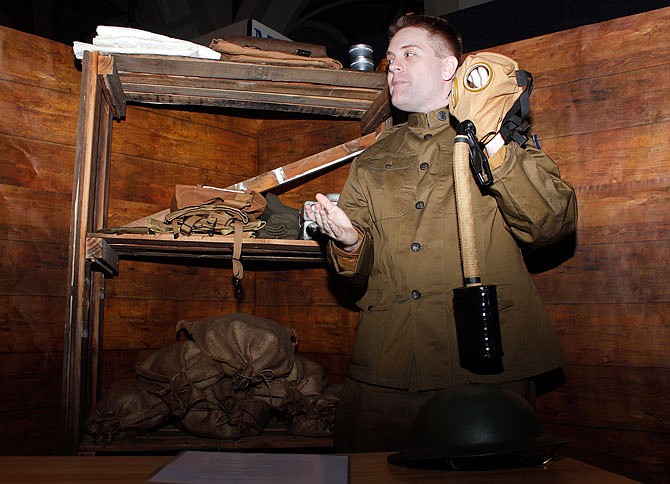On Veterans Day - for one day only - the Missouri State Museum at the Capitol offered special demonstrations observing the century anniversary of the United States' entry into World War I.
Museum visitors were urged to "register" for the draft, then were treated to a very brief discussion of the six weeks of basic training new American soldiers received before being shipped off to Europe in 1917-18.
Museum Director Tiffany Patterson told the News Tribune: "Our World War I exhibit will be up through 2019," although parts of it will be changed about every six months.
The overall exhibit, "Here at Home in Missouri, in the Great War," shows visitors "what we, as Missourians, were doing during that time" a century ago, Patterson explained. "We wanted to give a mix of what was happening at home, along with the experience of soldiers overseas."
The displays are based on information from "a lot of letters and a lot of diaries," Patterson said.
On Saturday, some tour guides dressed in period costumes.
Lucas Schwartze explained the importance of the soldiers getting outfitted well for their war efforts - including metal helmets, gas masks and wool socks - to avoid a condition called trenchfoot, which could set in in about 13 hours as soldiers often stood in muddy, cold conditions for hours on end.
The cold and wet would reduce blood circulation which could lead to tissue damage, infections and sometimes amputations, Schwartze said.
That impressed Trinity Lutheran student Kellen Dunn, 13, who toured the museum Saturday with his mom and brother.
"I never really thought about how cold it would be out in those trenches," he said.
Overall, he said, the museum displays and the extra interpretations Saturday were "pretty cool."
"They showed us a lot of stuff that I never had thought of about World War I."
The helmets, Schwartze noted, were made from a "single piece of metal, which made it very fast to mass-produce" and "made it a fairly strong helmet (that) wasn't likely to break apart if it got hit" by shrapnel aimed at the Allied soldiers in the trenches.
Gas masks helped protect soldiers from chemicals released to make the Allied soldiers get sick and, in some cases, blind.
Canaries and slugs were among the animals used to help detect gas releases, Carrie Hammond told the visitors.
More than 16 million animals were shipped to Europe for the war effort, she told the small tour groups, with about 8 million of those animals being horses and mules.
Although there were vehicles available for the war, Hammond said, the animals were cheaper to operate and care for and were able to better cross the rough land caused by trenching and wet weather without getting stuck the way many of the vehicles did.
Only 10,000-20,000 horses survived the war, she said.
Some dogs were used to carry medical supplies to wounded soldiers on the battlefields.
A number of cats were used to kill the rats and other vermin that haunted the trenches.
Pigeons were used to send messages from troops on-the-move back to headquarters.
Even with advances in medical care, Karla Strain - dressed as a Red Cross nurse - told the visitors, diseases were a constant problem.
About 90 percent of all soldiers got lice, she said.
Around 50 percent contracted typhus, while others suffered from the mange, flu or other illnesses.
Strain also said the war was one of the places where women played a big role for the first time in human history.
Tricia Schlechte added women from many western Missouri cities - as well as Jefferson City, Columbia and St. Louis - used their own money to go to Sarcoxie in early 1918 to help with the strawberry harvest.
"Women working during World War I" became a "big push and support for women getting the right to vote in 1920," she said, which became a reality with the adoption of the 19th Amendment to the U.S. Constitution.
Schlechte said while a lot of people are familiar with the "Rosie the Riveter" stories of women helping in factories during World War II, their World War I predecessors "weren't just homebodies or doing your typical 'women's work' of clerks or saleswomen. They were actually working in the factories, operating those drill presses and operating those lathes."
And in addition to the right to vote, the women's work in World War I helped make it easier for women to help the efforts when World War II began just more than two decades later.

